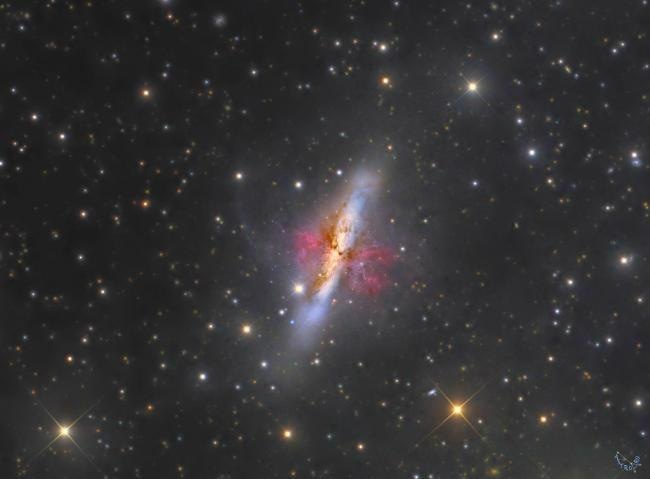Reviewed by Alex SmithAug 2 2021
The Messier 82, or M82, is a radiant infrared galaxy located nearly 12 million light-years away from the Milky Way. Its explosion of star formation energizes the radiation and generates a bipolar superwind that develops next to the galaxy’s core.
 An optical image of the luminous infrared superwind galaxy M82. The image highlights in red the wind emission in the radiation from filaments of ionized hydrogen. Some of the gas in the superwind, enriched in heavy elements forged in massive stars, will eventually escape into intergalactic space. Astronomers used Stratospheric Observatory for Infrared Astronomy (SOFIA) to map the magnetic field that drives this wind in M82. Image Credit: Alentejo Remote Observatory, Team ARO.
An optical image of the luminous infrared superwind galaxy M82. The image highlights in red the wind emission in the radiation from filaments of ionized hydrogen. Some of the gas in the superwind, enriched in heavy elements forged in massive stars, will eventually escape into intergalactic space. Astronomers used Stratospheric Observatory for Infrared Astronomy (SOFIA) to map the magnetic field that drives this wind in M82. Image Credit: Alentejo Remote Observatory, Team ARO.
The wind stretches in the direction perpendicular to the galactic plane out into the halo and intergalactic medium, and the ionized gas in the wind follows a constant structure that spreads around 30,000 to 40,000 light-years long. Astronomers assume that the formation of stars along the superwind is exciting the gas and also tends to produce X-ray emission, where the latter is generated by associated shocks.
M82 is like any other in having an outflowing wind, but since it is positioned comparatively closer and seen almost edge-on, the study of its outflow is simpler.
An important question is about the material that flows in the wind. In case it tends to escape and deposit into the space present between galaxies, it enhances the intergalactic medium. However, in the case of recirculation back onto the galaxy, it possibly redistributes the material and induces star formation in outer regions.
The magnetic field in the wind tends to push and help to shape the resulting formation. The particulars rely on whether the field lines spread and “open” or “close” into space, looping or curling throughout the galaxy and remaining more rigid.
Until now, the magnetic fields in the galactic outflows were analyzed with the polarized radiation generated at radio wavelength by electrons that move in the ionized flow. Previous research on M82 has shown that the magnetic fields tend to stretch from the central region and extend perpendicularly to the disk. However, the interpretation is complicated and the research varies based on the open and closed nature of the field lines.
Astronomer Mahboubeh Asgari-Targhi from the Center for Astrophysics (CfA) was a member of the team that identified that the scattered infrared radiation obtained from the dust grains lined by the magnetic fields could answer several questions.
The researchers used High-resolution Airborne Wideband Camera-plus (HAWC+) on NASA’s Stratospheric Observatory for Infrared Astronomy (SOFIA) to map the magnetic fields in M82 and integrated their outcomes with an altered method, generally utilized by solar astronomers who study the magnetic fields of the Sun.
The novel method generalizes the quantified wavelength with a few reasonable approximations regarding the existing electrical currents. The researchers were able to complete the details with other polarization information obtained from the literature.
For the first time, the researchers revealed that the M82 field lines are open, and also the energy in the turbulent motions is almost similar to those in the magnetic field. The study findings suggest that the outflow winds related to the starburst scenario in galaxies impart enriched material into the intergalactic medium.
Journal Reference:
Lopez-Rodriguez, E., et al. (2021) The Strength and Structure of the Magnetic Field in the Galactic Outflow of Messier 82. The Astrophysical Journal. doi.org/10.3847/1538-4357/abf934.